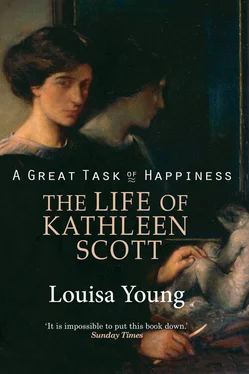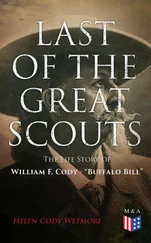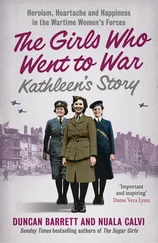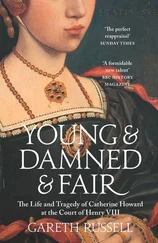In many ways the Bruce children’s life in Edinburgh is reminiscent of E. Nesbit’s Five Children and It , only there were more of them. William Skene was an amiable though strictly Episcopalian academic with no children of his own. Elma and Zoe, the first twins; Irene, Douglas, Lloyd and Gwen, the second twins; Rosslyn, Wilfrid, Hilda (known as Presh), Podge and Kathleen ‘generally struck out an original line of our own, and none of us were ever at a loss to know what to do with ourselves,’ Podge wrote. ‘We were very independent and hated to be interfered with.’ One governess suffered for weeks after being so ill-mannered as to wonder whether Kathleen had brushed her hair properly. (Brushing hair was a subject fraught with pitfalls. One of the worst accusations you could make to an Edinburgh child of the time was that she ‘brushed her hair underneath’—presumably to do with vanity, or laziness, or both. Kathleen’s hair was so long and thick that she was called ‘lanky locks, chatterbox’ even though she was rather a quiet child.)
Ostensibly well brought up, in navy blue jerseys with white lace collars, a neat ribbon at the neck and always a hat, they were in fact a bunch of little monkeys—Elma, Zoe and Irene excluded. The eldest brother Douglas is remembered with his feet up on the nursery mantelpiece, eating sweets; Presh christened their black straw Sunday hats the Flyaway Hats and would do her best to ensure that hers did; even Wilfrid, the kind and gentle one, had such a terrible fight with a nursemaid over the washing of his neck that blood was drawn. Rosslyn was first expelled from school at six for lifting the lady teachers’ skirts: ‘I only wanted to see if they had legs,’ he explained. Later he made a habit of getting expelled, largely because he insisted on keeping his animals with him at all times. This habit stayed with him all his life: as a full-grown clergyman he would preach with a lemur peeping out of his pocket; produce a grass-snake in Sunday School to illustrate the story of Adam and Eve (prompting one small pupil to tell his mother that Rev. Bruce kept the devil in his pocket) and unloose a white dove during a sermon on the Holy Spirit. His middle name was Francis, and his nickname d’Assisi.
The young Bruces delighted in tormenting their great-uncle and their governesses. One, a Miss Sandeman, arrived the same day as Rosslyn’s new incubator. (Rosslyn bred mice; in later life his ambition was to breed green ones. It took him fifty generations, he claimed, and was reported in the Daily Sketch . He also bred a terrier for Queen Victoria, when he was six.) The children decided to exchange their names, and the height of their success was when their great-uncle came into the schoolroom and said ‘Good morning, Miss Incubator.’ They used to hide from her and tease her: ‘She, poor soul, suffered much, and was powerless,’ admitted Podge. Another was a Presbyterian but agreed to take them to their (Episcopalian) church: ‘We knew she would know nothing of the service so we made up our minds to astonish her with every form of ritual we could imagine, finally arranging that at the second last prayer (St. Chrysostom) we should kneel with our backs to the altar …’ Kathleen had a black velvet dress (they spent a lot of time in mourning, for their mother, their father, their grandfather, their uncle the Archbishop of York) which was very stiff and would stand up on its own; Podge would sit it up on the bed with shoes and stockings dangling and invite Bertha the maid to come and have hysterics at the sight of Kathleen’s headless body.
The highest mark they could get for schoolwork was 3; if they got enough 3s they would have a treat. Feeling that the 3s were not coming fast enough, Podge and Kathleen stole their mark books and took them to the Botanical Gardens with a pencil and an India rubber, where Podge practiced and practiced to form a 3 like Miss Incubator’s, and then awarded 3s wherever the children felt they were deserved. The ruse was not discovered, and Podge claimed that she wrote her 3s like Miss Incubator’s till the end of her days.
When they started school Podge used to play truant regularly; she would lurk in the ‘Botans’ and when spotted (one of her brothers told on her) she claimed she had gone in there to do up her petticoat. In the end she and Kathleen both were hauled up before the curator of the Botans for consistently breaking rules—they had a running feud with the head gardener there, Foxy—but managed to get off because Great-Uncle William was a friend of the curator. They used to fiddle the accounts for their schoolbook buying in order to have more money for sweets, and at one school at least children were warned against ‘those awful Bruce girls’.
In a religious Victorian family all this naughtiness should have been more serious than it might be considered today, but there really was nobody to keep track of all of them. Elma, who had become what Kathleen described as ‘rather unwholesomely religious’, perhaps on account of her responsibilities, certainly tried, but she could not always succeed. She took her small siblings on religious retreats, which simply made them naughtier. She would listen to them read their collects every Sunday, and ask them questions. ‘Who was David?’ she asked Kathleen. ‘A ma..a..a..n,’ replied Kathleen, irritatingly if accurately. ‘Well, did you think I thought he was a pig?’ Elma snapped. She also tried to make Kathleen eat mutton fat; Kathleen just developed a technique of hiding it in her pocket. ‘Kathleen has got quite sensible about her food now,’ Elma would say. ‘These things, of course, only need a strong hand.’ Kathleen, meanwhile, was slyly dropping little packets of mutton fat in the gutters of the streets of Edinburgh.
Great-Uncle William had poor sight: he didn’t notice when they used a red-hot poker to brand numbers on the backs of a set of polished mahogany chairs (the chairs were being pupils in the children’s school, and they needed to be able to tell them apart, so they knew which one had taken its turn at reading, and which one was due to spell). There was an ancient chest, a family heirloom through the Skenes, which had belonged to Bonnie Prince Charlie: the little girls labeled each drawer of it with the names of their dolls, and on one occasion cut a piece of cloth off the old kilt that lived in the secret drawer to make a plaid for their doll Gerald. The kilt too had belonged to Prince Charlie, he’d worn it on his escape to the Isles, or so it was said. Uncle William never noticed any of these things. He didn’t even always notice whether or not the plates were in place when he dished out the stewed prunes, much to the children’s delight. He was not a fool about the children, though. When they waylaid the serving staff, hijacked their uniforms and served dinner to the grown ups Uncle William would never quite let on whether or not he had noticed.
On one occasion while Elma was away Podge devised a way of missing church. Uncle William asked her if she would like to be punished now or wait for Elma to return; Podge was scared enough to prefer to wait for Elma. In fact Uncle William was not strict. There was a tawse in the house, but it was more often used on him in play than it was on the children. Podge had merely been infected with something of Kathleen’s fear of men.
Although later in life Kathleen would say that she had only ever been interested in male creatures, this was not true. She recalled herself having had girl dolls, but having ‘put all kindly but firmly to bed with measles. So, through life, let all females be kindly and comfortably disposed of, so that my complete preoccupation with the male of the moment be unhampered!’ Her boy doll (Gerald—he of the plaid), ‘a sailor boy with blue eyes and brown curls’, went ‘everywhere with me’, and was ‘my idol, my baby, my love’, so Kathleen recalled. Podge, on the other hand, clearly recalls a small Kathleen trailing her beloved girl doll Rosie around. Certainly Kathleen, however she may have seen herself, was not one to dispose of women. Far from it: she spent plenty of her adult time delivering babies, caring for their mothers and looking after her female friends in trouble. At this stage she did not like men at all.
Читать дальше












